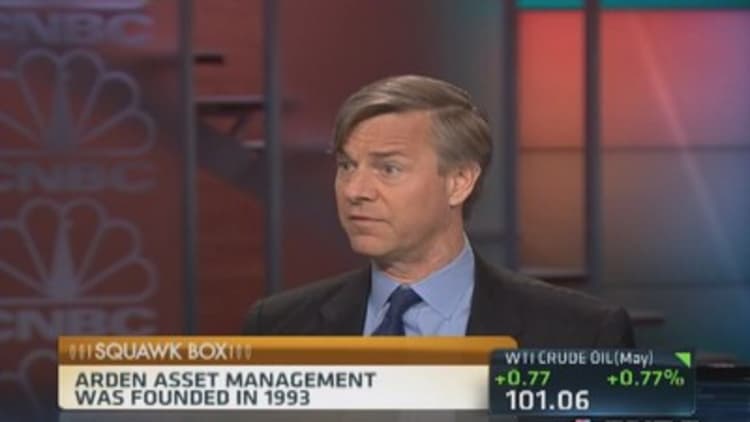Active fund managers have struggled for decades to beat the index. Even Warren Buffett is on a four-year losing streak and has instructed his wife to invest the majority of her trust in an S&P 500 index fund.
Maybe active managers have been going about it all wrong in the search for alpha — or, in other words, performance that beats the benchmark.
An increasing number of financial advisors and high-net-worth investors are paying up for downside protection rather than eye-popping performance. That's notable amid current market volatility. These investors aren't using hedge funds to limit risk, either. As counterintuitive as it may seem, passively managed ETFs—packaged as a tactical fund of funds—are the latest trend in active investing.
"You could probably do 85 percent to 90 percent of what a sophisticated stock and bond hedge fund was doing just with indexes," said John Forlines III, founder and chief investment officer of JAForlines, an ETF strategist.
For the first wave of growth in the active ETF strategists, you have to go back to the 2008 pullback, when the tactical strategists underweighted equities. "They had a risk-dampening aspect to portfolios that looked really good, when long-only strategies and most investors got crushed," said Matt Hougan, president of analytics and publications at ETF.com.
In fact, many ETF strategists have underperformed the S&P 500 in its recent extended bull run, yet the ETF strategist industry's growth rate has still been impressive: on pace to reach $120 billion in assets by next year, according to BlackRock, which runs the iShares family of ETF (ETF strategist funds—portfolios with at least 50 percent of assets in ETFs—had $96 billion in assets at the end of 2013, according to Morningstar).
Best-performing ETF strategist funds
| Name | 5-year | 3-year | 2013 |
| Keystone Wealth Glb Equity Alpha Rotation | 29.69% | 23.24% | 19.89% |
| Winterset Active/Edge ETF Growth | 23.48% | 23.81% | 14.55% |
| Keystone Wealth Comm AlphaRotation | 23.41% | 6.90% | -35.83% |
| Winterset Active/Edge Moderate Hybrid | 22.84% | 20.67% | 14.65% |
| Good Harbor Tactical Core US | 22.22% | 16.39% | 27.08% |
| Glovista Global Emging Market Equities | 21.67% | 0.13% | 2.51% |
| TTM Momentum-Growth | 21.03% | 10.23% | 29.19% |
| F-Squared AlphaSector Premium Index | 19.48% | 15.99% | 32.87% |
| F-Squared Premium AlphaSector Index | 18.92% | 15.20% | 32.02% |
| Horizon Focused ETF Portfolio | 18.76% | 13.73% | 27.88% |
Source: Source: Morningstar (year-end 2013 data)
The allure of the ETF strategists is easy to understand.
"They are more tailored to the volatile world we are living in," said Katharine Earhart, head of the iShares Connect Program at BlackRock. "In the past few years, what investors have seen makes them want to stay invested, but they see wild fluctuations in the market, and it is scary."
Scott Kubie, chief strategist at $6 billion CLS Investments, a money manager that runs ETF strategy funds, said there are a few reasons for the increased interest in this approach to active management. "They are focusing on adding returns, but they are also providing superior risk management, and this aspect is often under-appreciated," he said.
"Given how badly people were burned in the worst of the financial crisis, I think investors are just hoping they can find a strategy that will avert the next crisis or mitigate the sting of the next crisis," said Ben Johnson, director of passive investments at Morningstar.
Read MoreAre smart beta ETFs as good as they claim?
Some investors may be seeking a manager with the latitude to go to cash or bonds at a point in time if equities tumble, Johnson explained. "People are looking for more nimble asset allocation strategies ... not to say that they will be able to deliver those results, but the potential is there," Johnson said.
Biggest ETF strategist asset managers ($M)
| Name | Total assets | 2013 asset growth |
| F-Squared Investments | 19,841 | 11,307 |
| Windhaven Investment Management | 18,573 | 4,974 |
| Good Harbor Financial | 10,440 | 6,683 |
| *Morningstar | 5,032 | 1,467 |
| RiverFront Investment Group | 4,238 | 876.7 |
| Innealta Capital | 3,292 | -420 |
| Churchill Management Group | 2,732 | -270 |
| Sage Advisory Services | 2,327 | -196 |
| Cougar Global Investments | 1,371 | -727 |
| Clark Capital Management Group | 1,359 | -106 |
Source: Source: Morningstar (year-end 2013 data)
"ETF strategists are push thinking on how to look at active management," Earhart said. "They say, 'We don't fit into Morningstar-style boxes. ... That kind of construction doesn't work for us' ... "It's evolving."
The more ETF strategists try to differentiate themselves from the hordes trying to beat the S&P, the more there is a question about appropriate benchmarks, Johnson said.
He added, "They don't have that narrow of an objective or mandate." Or, in other words, you don't have to beat the benchmark if you don't set out to compete with it.
Read MoreA tidy way to turn market dogs into timely ETF bets
"The reality of a lot of the ETF strategists is that they are, in fact, active mangers riding in the sheep clothing of ETFs," said Dave Nadig, chief investment officer at ETF.com, adding, "There is no central clearinghouse for what ETF strategists are doing."
Investors should be asking if these strategists are delivering on their goals over a reasonable time frame, Johnson said.
"Lots of these strategies lagged the S&P in 2013," said Patrick Newcomb, senior analyst at Cerulli Associates. "But if the financial advisor takes money out and the market drops the next year, the whole point of protecting on the downside was useless."

The efficiency of ETFs as an asset allocation tool has played into these managers' hands. "It seems to make a more compelling story for folks to let an asset allocator use ETFs," said Barry Fennell, senior research analyst at Lipper.
Read MoreBonds vs. bond funds: What you need to know now
Kubie said that CLS can now invest in countries and regions that would have been challenging to access in the past.
"The 'set it and forget it' model ... As an end investor, the psychology of not doing anything to the portfolio is unsettling. They want to see someone responding to volatility," Earhart said.
According to Nadig, there has always been a class of investors who believe in active management. The difference is, he said, "They are now hoping someone will get them out of China at the right time instead of getting them out of Microsoft at the right time."




